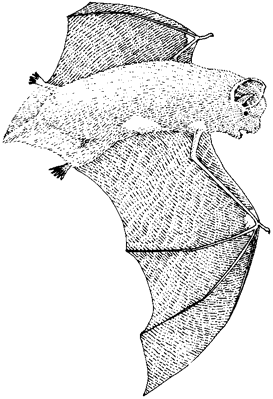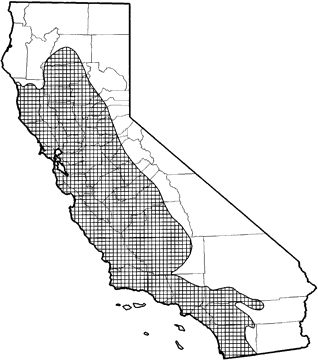
Western Red Bat
Distribution, Abundance, and Seasonality
The red bat is locally common in some areas of California, occurring from Shasta Co. to the Mexican border, west of the Sierra Nevada/Cascade crest and deserts. The winter range includes western lowlands and coastal regions south of San Francisco Bay. There is migration between summer and winter ranges, and migrants may be found outside the normal range. Roosting habitat includes forests and woodlands from sea level up through mixed conifer forests. Feeds over a wide variety of habitats including grasslands, shrublands, open woodlands and forests, and croplands. Not found in desert areas. During warm months, sexes occupy different portions of the range (Williams and Findley 1979).

Range Map
Specific Habitat Requirements
Feeding: Feeds on a variety of insects. The most important prey are moths, crickets, beetles, and cicadas. Foraging flight is slow and erratic. Though capable of rapid, direct flight, it is maneuverable. Utilizing echolocation, captures insects in wing and tail membranes. Frequently seen foraging in large concentrations. Foraging may be from high above treetops to nearly ground level. The same foraging route may be followed on many occasions.
Cover: Roosts primarily in trees, less often in shrubs. Roost sites often are in edge habitats adjacent to streams, fields, or urban areas. Preferred roost sites are protected from above, open below, and located above dark ground-cover. Such sites minimize water loss. Roosts may be from 0.6-13 m (2-40 ft) above ground level. Females and young may roost in higher sites than males.
Reproduction: Young are born and roost in sites with the characteristics described under cover requirements. Family groups roost together. Nursery colonies are found with many females and their young.
Water: Requires water.
Pattern: Prefers edges or habitat mosaics that have trees for roosting and open areas for foraging.
Species Life History
Activity Patterns: Nocturnal. Hibernates. Begins foraging 1-2 hr after sunset; may forage throughout the night, with a second peak before sunrise. Has been seen at temperatures as low as 7Á C (44Á F), but generally active above 20ÁC (68ÁF). In cold climates spends the winter in hibernation, with arousals on warm winter days.
Seasonal Movements / Migration: Migratory. In California, most individuals probably make relatively short migrations between summer and winter ranges. Migrates in the spring (March-May) and autumn (September-October). They may be found in unusual habitats during migration.
Home Range: Foraged from 0.5-0.9 km (0.3-0.6 mi) from the day roost in Wisconsin (Jackson 1961). Densities of 2/ha (1 /ac) are reported in lowa (McClure 1942).
Territory: Usually solitary, although nursery colonies occasionally are found. Not territorial.
Reproduction: Mating occurs in August and September. After delayed fertilization there is an 80-90 day gestation. Births are from late May through early July. Most females bear 2 or 3 young, though the single litter may have 1-5. Lactation lasts 4-6 wk, and the young are capable of flight between 3-6 wk of age. Females may move the young between roost sites.
Niche: Found foraging or drinking with many other bat species, but usually does not roost with other species. Red and hoary bats are inversely related in abundance in lowa (Kunz 1973). Rabies incidence in red bats is relatively high (Shump and Shump 1982). A variety of animals, including owls, hawks, opossums, cats, and jays preys on red bats.
Sources & References
California Department of Fish and Game, 1999.
California's Wildlife, Sacramento, CA.
Written by: J. Harris, reviewed by: P. Brown, edited by: D. Alley, R. Duke
Barbour, R. W., and W. H. Davis. 1969. Bats of America. Univ. of Kentucky Press, Lexington. 286pp. Brown, P. E. 1980. Distribution of bats of the California Channel Islands. Pages 751-756 in D. M. Power, ed. The California Islands. Santa Barbara Mus. Nat. History. 787pp. Constantine, D. G. 1959. Ecological observations on lasiurine bats in the North Bay area of California. J. Mammal. 40:13-15. Constantine, D. G. 1966. Ecological observations on lasiurine bats in Iowa. J. Mammal. 47:34-41. Davis, W. B. 1960. The mammals of Texas. Texas Game and Fish Comm., Austin. 252pp. Davis, W. H., and W. Z. Lidicker, Jr. 1956. Winter range of the red bat, Lasiurus borealis. J. Mammal. 37:280-281. Farney, J., and E. D. Fleharty, 1969. Aspect ratio, loading, wing spans and membrane area of bats. J. Mammal. 50:362-367. Grinnell, H. W. 1918. A synopsis of the bats of California. Univ. Calif. Publ Zool. 17:223-404. Hamilton, W. J., Jr. 1943. The mammals of eastern United States. Comstock. Publ. Co., Ithaca, NY. 432pp. Jackson, H. H. T. 1961. Mammals of Wisconsin. Univ. Wisconsin Press, Madison. 504pp. Kunz, T. H. 1971. Reproduction of some vespertilionid bats in central Iowa. Am. Midland. Nat. 86:477-486. Kunz, T. H. 1973. Population studies of the cave bat (Myotis velifer): reproduction, growth and development. Occas. Pap. Univ. Kans. Mus. Nat. Hist. 15:1-43. La Val, R. K., and M. L. La Val. 1979. Notes on reproduction, behavior, and abundance of the red bat, Lasiurus borealis. J. Mammal. 60:209-212. McClure, H. E. 1942. Summer activities of bats (Genus Lasiurus) in Iowa. J. Mammal. 23:430-434. Orr, R. T. 1950. Unusual behavior and occurrence of red bats in San Francisco. J. Mammal. 31:456-457. Orr, R. T. 1950. Notes on the seasonal occurrence of red bats in San Francisco. J. Mammal. 31:457-458. Shump, K. A., Jr., and A. U. Shump. 1982. Lasiurus borealis. Mammal. Species No. 183. 6pp. Williams, D. F., and J. S. Findley. 1979. Sexual and size dimorphism in vespertilionid bats. Am. Midl. Nat. 102:113-126.
California Animal Facts | California's Wildlife